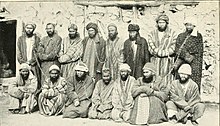| Andijan uprising of 1898 | |||||||
|---|---|---|---|---|---|---|---|
| Part of the Russian conquest of Central Asia | |||||||
 Insurgents under arrest, 1899 | |||||||
| |||||||
| Belligerents | |||||||
|
|
| ||||||
| Commanders and leaders | |||||||
| Aleksandr Povalo-Shveykovsky [ru] |
Muhammad Ali Madali | ||||||
| Strength | |||||||
| 1,500 | |||||||
| Casualties and losses | |||||||
|
| ||||||
| Russian conquest of Kokand | |
|---|---|
|
| Russian conquest of Central Asia Campaigns and theaters | |
|---|---|
The Andijan uprising of 1898 was a nationalist rebellion which occurred on 29 May [O.S. 17 May] 1898. Around 1,500 armed men attacked the Russian forces at Andijan (formerly part of the Khanate of Kokand), under the direction of the Naqshbandi Sufi sheikh "Dukchi Ishan" (Muhammad Ali Madali) (1856–1898). The attack saw the rebels surround the camp, taking the soldiers of the 20th Russian battalion by complete surprise. However, the Russian troops quickly regrouped and managed to rout the rebels. The uprising lasted about 15 minutes.
Twenty-two Russian soldiers died, and 16 were wounded. Other attacks were staged simultaneously at Margilan and Ush. Eighteen participants were executed, including the leader. 546 rebels were arrested, and 356 condemned to forced labour or exile to Siberia (163 were set free). The rebel leader was thought to be representative of the Ottoman Empire (but the credentials proved false), and he was declared khan the day before the revolt.
The majority of the rebels were Kyrgyz, who in 1875 had rebelled against Muhammad Khudayar Khan (who reigned 1845–1858, 1862–1863, and 1867–1875).
Edward Dennis Sokol points out that while this affair might seem insignificant at first glance, it actually revealed widespread dissatisfaction with Tsarist rule in Central asia.
Motives
When the leader of the revolt was asked why he had revolted, he replied:
- That after the conquest by the Russians there took place a strong deterioration in the morals of the people
- Russian non-compliance with Sharia
- That the Russian government, though lenient in their relations with the natives, forbade pilgrimages to Mecca
- The abolition of zakat or religious tax
- Tampering with waqf laws
- That they did not trouble about the support of morality and family life
Notes
References
- ^ Sokol, Edward Dennis (2016). The Revolt of 1916 in Russian Central Asia. JHU Press. pp. 50, 51, 52. ISBN 9781421420509.
- Peterson, Maya K. (2019). Pipe Dreams: Water and Empire in Central Asia's Aral Sea Basin. Cambridge, United Kingdom: Cambridge University Press. p. 120. ISBN 9781108673075.
Bibliography
- Hisao Komatsu, The Andijan Uprising Reconsidered a: Symbiosis and Conflict in Muslim Societies: Historical and Comparative Perspectives, ed. by Tsugitaka Sato, Londres, 2004.
- Erkinov A.S. The Andijan Uprising of 1898 and its leader Dukchi-ishan described by contemporary Poets. TIAS Central Eurasian Research Series No.3. Tokyo, 2009, 118 p.
- Richard A. Pierce, Russian Central Asia 1867–1917 – A study in colonial rule, Berkeley/Los Angeles, 1960